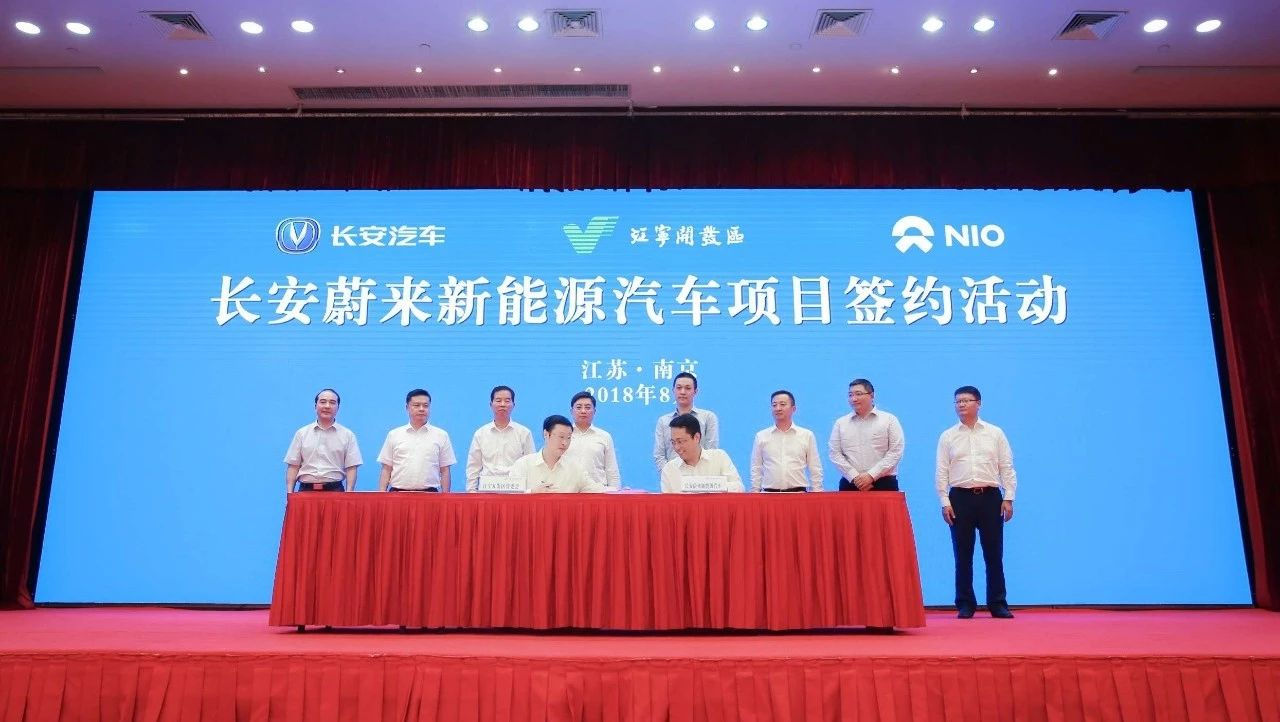After JAC, the cooperation between NIO and Changan landed. Here are some details:
On August 17th, the joint venture company “Changan NIO New Energy Automotive Technology Co., Ltd.”, which is jointly funded by Changan Automobile and NIO, was settled in the Jiangning Development Zone in Nanjing. The company’s business will cover the entire industrial chain of intelligent network connectivity, new energy vehicle industry technology research and development, parts production, and operation services.
However, the agreement signed on April 9th last year is much more detailed:
The cooperation between Changan and NIO will explore innovative business models to jointly make positive explorations in pure electric vehicle development, intelligent automobile cutting-edge technology, sales service models, integration of the industrial chain, big data analysis and software application, and innovative management mechanisms.
Changan will leverage its ability to operate the entire automotive industry chain to achieve large-scale global development, global manufacturing, and global delivery of automotive products. NIO, with the user-centric concept of Internet thinking and ultimate user experience, will reconstruct the automotive sales system.
Both parties will actively explore new business models such as battery leasing, reservation-based sales, and membership-based sales, and build a “leading, extremely experiential” new energy vehicle marketing platform.
In fact, the Changan NIO model is very interesting. Li Bin has always emphasized that this company is different from traditional joint ventures and should be called a joint creation company.
The new company Changan and NIO each hold 45% of the shares, and the remaining 10% of the shares are held by the management team. With equity incentives, the attractiveness to talents is much better than that of traditional joint ventures.
In fact, this is also NIO’s method. By allowing management to hold shares and implementing responsibility to the management team, everyone is more likely to be all in. In NIO’s IPO prospectus disclosed a few days ago, many NIO executives appeared among the board members.
In addition, there are the aforementioned key points: battery leasing, reservation-based sales, and membership-based sales. Does it sound familiar?
NIO’s entire electric energy service system (NIO Power) now seems to be a system that reduces efficiency in order to improve the user experience.
NIO’s vision is that in the future, there will be enough models with battery specifications and support for battery swapping on the road similar to the ES8. In addition to the operation and maintenance of infrastructure, the key to the entire electric energy service system will become matching and scheduling of energy supply and demand on both sides through background big data algorithms.
The ideal situation is to ensure that all car owners’ energy supplementation experience is not discounted, while maintaining the minimum idle rate of battery swapping stations and mobile charging vehicles.This creates a paradox. In order to ensure the user experience and live up to the official website’s statement that “charging is more convenient than refueling,” NIO must maintain a certain level of redundancy in its entire energy system. As Li Bin said before, NIO must ensure that the reserve quantity of its delivered vehicles maintains a 1:1.5 ratio with its overall service capacity.
To improve supply-demand matching efficiency and reduce idle time by decreasing the ratio from 1:1.5 to 1:1.2 or even 1:1.1 within the same geographic area, the only solution is to rapidly increase the number of vehicles owned by NIO.
However, there is a significant risk if NIO solely increases its own vehicle ownership, as it took Tesla five years to go from zero to 100,000 vehicles per year in production capacity. Can NIO outperform Tesla in terms of speed?
Therefore, the solution is to open the entire energy service system, enabling battery swapping stations and mobile charging cars to become as common as fast-charging stations for energy infrastructure.
Therefore, you can see Changan NIO as the first external company to join NIO’s energy service ecosystem after NIO. For NIO, the significance of this joint venture goes beyond this. Changan NIO is based in Nanjing. NIO also has an electric motor and control system production base in Nanjing, designed to have an annual output of 280,000 units.
NIO has made it very clear before that the electric motor and control system base will not only supply NIO but also cooperate with other automakers. Needless to say, the EV powertrain suppliers for future Changan NIO products and NIO ES8 are highly consistent, with differences likely only in performance parameters.
For Changan, working with NIO is also pure motivation. All traditional OEMs are seeking transformation. “It’s better to find a knowledgeable partner than explore alone,” said Changan President Zhu Huarong.
Li Bin has obviously thought deeply about it, positioning Changan NIO as lower than NIO’s own brand. Today, he said, “Changan NIO will help products enter a more mainstream market.” In other words, no matter how many models NIO releases, Changan NIO will cut the cake in the low-end market with its own price, enabling NIO to maintain its brand positioning for luxury intelligent EVs.Changan and NIO have given considerable attention to this new company. Li Bin serves as the chairman of the new company, and the vice chairman is Li Wei, the executive vice president of Changan Automobile and general manager of Changan New Energy. The CEO of the new company, Yang Fang, is also from the Changan group and used to be the vice minister of the Department of Science and Technology and Project Management at Changan.
The official introduction says that Yang Fang “has worked for many years in foreign-funded, joint ventures, and independent brand car companies, and has rich experience in sales, marketing, research and development, and strategy across fields.” Three years later, we will see the results of the combination of traditional engineering and manufacturing resources and the internet resources of Changan and NIO.
Previously, Qin Lihong, the president of NIO, said that in the past, the automobile industry was a traditional industry in which the main engine factory was the leader, and the industry chain was integrated up and down. Water in different wells did not mix. In the future, it is very likely that alliances will be formed among main engine factories to play to their respective strengths and promote industry progress.
In my opinion, the positive impact of this horizontal integration strategy on NIO is actually greater than the benefits it brings to traditional car manufacturers. When you are in a main engine factory alliance and play the role of the hub of the alliance, to a certain extent, it will enhance NIO’s fault tolerance and development resilience in the development process.
Don’t forget that Li Bin still has the Guangzhou Automobile NIO brand under his control.
Whether Changan NIO can make a splash is crucial. There are too many traditional main engine factories in China. Do you know if those manufacturers that have not cooperated with NIO are not interested in internet thinking or are they just watching?



This article is a translation by ChatGPT of a Chinese report from 42HOW. If you have any questions about it, please email bd@42how.com.
